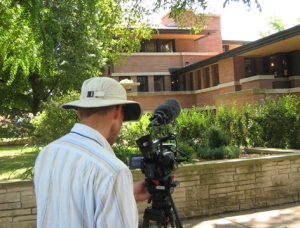I went to meet and interview Robert Darden, founder of the Black Gospel Music Restoration Project. Though I had read about him, read his books and articles, heard him on NPR, exchanged e-mails with him, and spoke with him on the phone, you never really know if a subject is going to be right until you meet him or her face-to-face.
Wolfgang and I had dinner with Robert and his wife, Mary, the night we arrived, and after that dinner there was no question: he was perfect for the film. He was open, articulate, wise, funny, and passionate. He and Mary made themselves available to us even though they were on a tight schedule, and Robert invited us to tag along as he interviewed subjects for a book he’s writing about gospel music’s role in the civil rights movement. Initially I wanted to conduct two interviews and perhaps follow him around as he searched for some rare vinyl.
What I got was two great interviews, a great scene of Robert perusing gospel records at Hyde Park Records (I loved this place, it’s very High Fidelity!), and footage of him interviewing two Chicago gospel performers for his book. We also shot b-roll exteriors of Robie House, a Frank Lloyd Wright residence that may be a nice transition if I’m going from Arcosanti (Soleri was Wright’s apprentice) to this Chicago footage or vice versa; the skyline from a beach on lake Michigan; those foot bridges over the Chicago River in downtown; and Cloud Gate, the Anish Kapoor sculpture in Millennium Park.
Nine hours of footage.
But that’s not all. In Part 3 I’ll reveal my big score.

